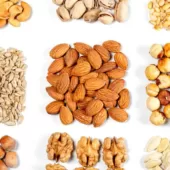Food groups are useful for nutrition statistics. But they have more practical value during meal planning. So I’m starting to categorize foods by their dietary planning group. Because this helps to relate national guidelines to food lists and meal plans.
Also, food groups are destined to be a fundamental part of measuring and monitoring diet quality[1]. So I will organize nutrient facts by food groups. Because that allows you to measure how healthy your diet is with respect to national guidelines. Then it helps you identify where you can make better food choices to improve the quality of your eating patterns.
Dietary Guidelines Food Groups Purpose
I extracted this list of food groups from the same dietary guidelines that your professional advisers are familiar with. So this supports the Purpose of ALKAscore. By helping you discuss your diet plans with your professional advisers. In ways that support your agreed health and wellbeing goals.
The purpose of this food groups list is to help you and your advisers measure and plan your diet. By categorizing your food intake into manageable groups. Where those groups are compatible with modern diet management principles.
Dietary Guidelines Food Groups List
These food groups and subgroups are defined in part 2 of Dietary Guidelines Appendix 3[2]. The nutrient dense food groups defining core elements of a healthy dietary pattern are:
DGA Food Group 1: Vegetables
Vegetables of all types – dark green; red and orange; beans, peas, and lentils; starchy; and other vegetables:
- Dark-Green Vegetables
- All fresh, frozen, and canned dark-green leafy vegetables and broccoli, cooked or raw: for example, amaranth leaves, basil, beet greens, bitter melon leaves, bok choy, broccoli, chamnamul, chrysanthemum leaves, chard, cilantro, collards, cress, dandelion greens, kale, lambsquarters, mustard greens, poke greens, romaine lettuce, spinach, nettles, taro leaves, turnip greens, and watercress.
- Red and Orange Vegetables
- All fresh, frozen, and canned red and orange vegetables or juice, cooked or raw: for example, calabaza, carrots, red chili peppers, red or orange bell peppers, pimento/pimiento, sweet potatoes, tomatoes, 100% tomato juice, and winter squash such as acorn, butternut, kabocha, and pumpkin.
- Beans, Peas, Lentils
- All cooked from dry or canned beans, peas, chickpeas, and lentils: for example, black beans, black-eyed peas, bayo beans, brown beans, chickpeas (garbanzo beans), cowpeas, edamame, fava beans, kidney beans, lentils, lima beans, mung beans, navy beans, pigeon peas, pink beans, pinto beans, split peas, soybeans, and white beans.
Does not include green beans or green peas. - Starchy Vegetables
- All fresh, frozen, and canned starchy vegetables: for example, breadfruit, burdock root, cassava, corn, jicama, lotus root, lima beans, immature or raw (not dried) peas (e.g., cowpeas, black-eyed peas, green peas, pigeon peas), plantains, white potatoes, salsify, tapioca, taro root (dasheen or yautia), water chestnuts, yam, and yucca.
- Other Vegetables
- All other fresh, frozen, and canned vegetables, cooked or raw: for example, artichoke, asparagus, avocado, bamboo shoots, bean sprouts, beets, bitter melon (bitter gourd, balsam pear), broccoflower, Brussels sprouts, cabbage (green, red, napa, savoy), cactus pads (nopales), cauliflower, celeriac, celery, chayote (mirliton), chives, cucumber, eggplant, fennel bulb, garlic, ginger root, green beans, iceberg lettuce, kohlrabi, leeks, luffa (Chinese okra), mushrooms, okra, onions, peppers (chili and bell types that are not red or orange in color), radicchio, sprouted beans (e.g. sprouted mung beans), radish, rutabaga, seaweed, snow peas, summer squash, tomatillos, turnips, and winter melons.
DGA Food Group 2: Fruits
Fruits, especially whole fruit, include all fresh, frozen, canned, and dried fruits and 100% fruit juices: for example, apples, apricots, Asian pears, bananas, berries (e.g., blackberries, blueberries, cranberries, currants, dewberries, huckleberries, kiwifruit, loganberries, mulberries, raspberries, and strawberries); citrus fruit (e.g., calamondin, grapefruit, kumquats, lemons, limes, mandarin oranges, pomelos, tangerines, and tangelos); cherries, dates, figs, grapes, guava, jackfruit, lychee, mangoes, melons (e.g., cantaloupe, casaba, honeydew, and watermelon); nectarines, papaya, passion fruit, peaches, pears, persimmons, pineapple, plums, pomegranates, prunes, raisins, rhubarb, sapote, soursop, starfruit, and tamarind.
DGA Food Group 3: Grains
Grains, at least half of which are whole grain:
- Whole Grains
- All whole-grain products and whole grains used as ingredients: for example, amaranth, barley (not pearled), brown rice, buckwheat, bulgur, millet, oats, popcorn, quinoa, dark rye, triticale, whole-grain cornmeal, whole-wheat bread, whole-wheat chapati, whole-grain cereals and crackers, and wild rice.
- Refined Grains
- All refined-grain products and refined grains used as ingredients: for example, white breads, refined-grain cereals and crackers, corn grits, cream of rice, cream of wheat, barley (pearled), masa, pasta, and white rice.
Refined-grain choices should be enriched.
DGA Food Group 4: Dairy
Dairy, including fat-free or low-fat milk, yogurt, and cheese, and/or lactose-free versions and fortified
soy beverages and yogurt as alternatives:
All fluid, dry, or evaporated milk, including lactose-free and lactose-reduced products and fortified soy beverages (soy milk), buttermilk, yogurt, kefir, frozen yogurt, dairy desserts, and cheeses (e.g., brie, camembert, cheddar, cottage cheese, colby, edam, feta, fontina, goat, gouda, gruyere, limburger, Mexican cheeses [queso anejo, queso asadero, queso chihuahua], monterey, mozzarella, muenster, parmesan, provolone, ricotta, and Swiss).
Most choices should be fat-free or low-fat. Cream, sour cream, and cream cheese are not included due to their low calcium content.
DGA Food Group 5: Protein Foods
Protein foods, including lean meats, poultry, and eggs; seafood; beans, peas, and lentils; and nuts,
seeds, and soy products:
- Meats, Poultry, Eggs
- Meats include beef, goat, lamb, pork, and game meat (e.g., bear, bison, deer, elk, moose, opossum, rabbit, raccoon, squirrel).
Poultry includes chicken, Cornish hens, dove, duck, game birds (e.g., ostrich, pheasant, and quail), goose, and turkey.
Organ meats include brain, chitterlings, giblets, gizzard, heart, kidney, liver, stomach, sweetbreads, tongue, and tripe.
Eggs include chicken eggs and other birds’ eggs.
Meats and poultry should be lean or low-fat. - Seafood
- Seafood examples that are lower in methylmercury include: anchovy, black sea bass, catfish, clams, cod, crab, crawfish, flounder, haddock, hake, herring, lobster, mackerel, mullet, oyster, perch, pollock, salmon, sardine, scallop, shrimp, sole, squid, tilapia, freshwater trout, light tuna, and whiting.
- Nuts, Seeds, Soy Products
- Nuts and seeds include all nuts (tree nuts and peanuts), nut butters, seeds (e.g., chia, flax, pumpkin, sesame, and sunflower), and seed butters (e.g., sesame or tahini and sunflower).
Soy includes tofu, tempeh, and products made from soy flour, soy protein isolate, and soy concentrate.
Nuts should be unsalted. - Beans, Peas, Lentils
- Can be considered part of the protein foods group. Or as part of the vegetable group. But should be counted in one group only.
DGA Food Group 6: Oils
Oils, including vegetable oils and oils in food, such as seafood and nuts. Cooking with oils higher in polyunsaturated and monounsaturated fat (e.g., canola, corn, olive, peanut, safflower, soybean, and sunflower) instead of butter also can reduce intakes of saturated fat.
DGA Food Group Summary
The 2020 guidelines emphasize nutrient dense foods and beverages. With daily and weekly targets organized across 6 food groups. Allowing 10% for extras such as alcohol, extra sugars, or any other personal favorites.
Beverages
Unlike earlier guidance, DGA 2020 has no separate food group for beverages. Instead there are:
- Recommendations quoted below
- Highlights regarding fortified soy beverages (commonly known as “soy milk”)
- Repeated recommendations to limit alcoholic beverages
- Emphasis on 100% juice (fruit and vegetable), avoiding sugar-sweetened beverages.
When choosing beverages in a healthy dietary pattern, both the calories and nutrients that they provide are important considerations. Beverages that are calorie-free—especially water—or that contribute beneficial nutrients, such as fat-free and low-fat milk and 100% juice, should be the primary beverages consumed. Coffee, tea, and flavored waters also are options, but the most nutrient-dense options for these beverages include little, if any, sweeteners or cream. For discussion on sugar-sweetened beverages or alcohol, see “Added Sugars” and “Alcoholic Beverages,” respectively.

Your Diet Food Groups
The dietary guidelines use food groups to simplify how you plan and monitor your eating patterns. But I cover that level of detail separately. However, now is the time to think about your meals in terms of the food groups listed above.
In particular, you should consider any advice from your doctor or other health professional. Does that advice clearly identify targets in these food groups? If not, consult your advisers about how their advice matches national guidelines.
I’m working on templates that help you identify, understand, and resolve your dietary guidelines concerns. In the meantime, you can start by adding notes about what you’ve learned about dietary guidelines so far.
All you do is highlight any text that interests you. Then click “Annotations” to personalize any Foodary page. Which means you can keep your dietary guidelines notes linked here, where you can always find them.
Do you need help with annotations? Or other unanswered questions or unresolved concerns? Then please tell me below. Or, if you prefer to use email, then subscribe to my free newsletter.
Leave Dietary Guidelines Food Groups List to read ALKAscore Food, Nutrient, and Diet Score News.
Dietary Guidelines Food Groups Comments
Please add your comments here. Or see more feedback options below.
Your feedback options are:
- Easy Food Comments. Add comments below.
- Focused Food Concerns. Create a new issue about any food research concern that you want to resolve. Or join an existing issue.
- General Food Chat. Start a new discussion about any food topic that interests you. Or join an existing discussion.
- Versatile Food Annotations. Annotations allow you to personalize Foodary pages to help you learn. But they also work as a feedback option. Especially if you use the Public Group, the Foodary Nexus Subscriber Group, or a Foodary Project Group. For more information, I recommend that you subscribe to my free newsletter.
If you are asking a question, it is best to:
- Search for that question in the Foodary Search Engine first.
- Choose the most relevant result.
- Refer to that result as you ask your question.
Dietary Guidelines Food Groups Related Topics
Please remember: to find more related pages that are relevant to you, use the search box near the top of every page.
Common Terms: sunflower
Other posts that include these terms:
- FODMAP Diet Highs and Lows
- Acid-Alkaline Nuts and Seeds PRAL List
- Alkaline Salad Dressing List
- Acid-Alkaline Yeast Breads PRAL List
Dietary Guidelines Food Groups References
- Drewnowski, A., Dwyer, J., King, J.C. and Weaver, C.M., 2019. A proposed nutrient density score that includes food groups and nutrients to better align with dietary guidance. Nutrition Reviews, 77(6), pp.404-416.
- U.S. Department of Agriculture and National Institutes of Health. 2020. Dietary Guidelines for Americans 2020–2025, 9th ed. US Department of Agriculture and US National Institutes of Health: Washington, DC, USA,



